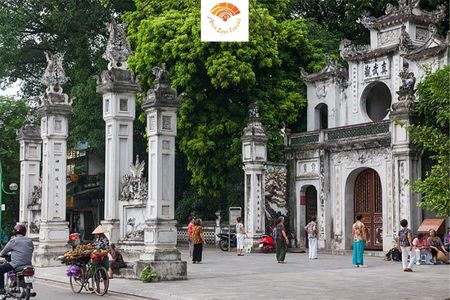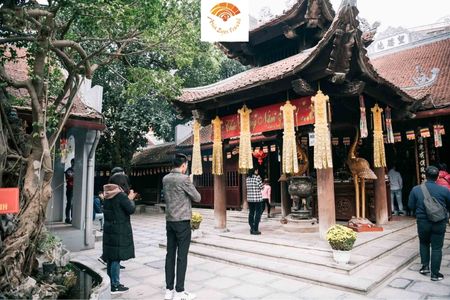Visiting pagodas at the beginning of Lunar New Year has become an age-old tradition of Vietnamese people. Following is the 10 spiritual destinations in Hanoi capital that most visitors should visit when arriving the city during the spring travel schedule.
1.Quan Su Pagoda in Hoan Kiem district
Located at No. 73 Quan Su street, Hoan Kiem district , Quan Su Temple is a precious treasure of Hanoi and has been the Headquarter of the Vietnam Buddhism Association since 1858.


Quan Su is always full of worshipers and visitors. Many people arrive here have the same feeling that the atmosphere inside the pagoda is really tranquil and restful.
2. Quan Thanh Temple in Ba Dinh district
Quan Thanh Temple, formerly known as Tran Vu Temple, is a Taoist temple in Hanoi. Dated to the 11th century, the temple was dedicated to Xuan Wu, or Trấn Vũ in Vietnamese, one of the principal deities in Taoism. As one of the Four Sacred Temples of the capital, Quan Thanh Temple is located near West Lake in a ward of same name, Quan Thanh Ward, and is one of the leading tourist attractions in Hanoi.


Legend has it that Quan Thanh Temple was established during the reign of Emperor Lý Thái Tổ (1010–1028) and was dedicated to Tran Vu, Deity of the North in Taoism, whose symbols of power are the serpent and turtle. It is one of the Four Sacred Temples that were built in four directions to protect the capital from malevolent spirits.
Nowadays, Quan Thanh Temple is located on the corner of Quan Thanh Street and Thanh Nien Street, facing West Lake.
Nowadays, Quan Thanh Temple is located on the corner of Quan Thanh Street and Thanh Nien Street, facing West Lake.
3. Ngoc Son Temple in Hoan Kiem district
Den Ngoc Son, or the Temple of the Jade Mountain is one of Hanoi’s most picturesque temples. It is built on an islet in Ho Hoan Kiem where, in the 16th-18th centuries, there was a country villa used by the Trinh mandarins when they boated on the lake.
In the 19th century, the site became a Buddhist pagoda, then a temple for the cult of a deified Chinese warrior, Quan Cong, and later for the Spirits of Literature and of the Soil. This shrine is now dedicated to Tran Hung Dao, a 13th century Vietnamese military national hero, scholar Van Xuong, and to Nguyen Van Sieu, a Confucian master who assumed responsibility for extensive additions and repairs made to the temple and the surrounding areas from 1864.
Den Ngoc Son, or the Temple of the Jade Mountain is one of Hanoi’s most picturesque temples. It is built on an islet in Ho Hoan Kiem where, in the 16th-18th centuries, there was a country villa used by the Trinh mandarins when they boated on the lake.

In the 19th century, the site became a Buddhist pagoda, then a temple for the cult of a deified Chinese warrior, Quan Cong, and later for the Spirits of Literature and of the Soil. This shrine is now dedicated to Tran Hung Dao, a 13th century Vietnamese military national hero, scholar Van Xuong, and to Nguyen Van Sieu, a Confucian master who assumed responsibility for extensive additions and repairs made to the temple and the surrounding areas from 1864.
4.Tran Quoc Pagoda in Tay Ho district
Hanoi, the capital of the Socialist Republic of Vietnam, spreads over 2,000 square kilometers, but most important sites lie in compact areas. You can also try a trip around West Lake that takes in the rural suburbs.T he most exciting fact about the pagoda is that the earliest example in the Oxford English Dictionary of the use of the word pagoda in English is from 1634. Pagoda – comes from Sanskrit “dhatu garba”. Tran Quoc Pagoda in Hanoi is one such piece of architecture.
Hanoi, the capital of the Socialist Republic of Vietnam, spreads over 2,000 square kilometers, but most important sites lie in compact areas. You can also try a trip around West Lake that takes in the rural suburbs.T he most exciting fact about the pagoda is that the earliest example in the Oxford English Dictionary of the use of the word pagoda in English is from 1634. Pagoda – comes from Sanskrit “dhatu garba”. Tran Quoc Pagoda in Hanoi is one such piece of architecture.


Tran Quoc Pagoda has been selected as one of 16 world’s most beautiful temples by Dailymail during spring 2016. Visiting one of the ancient temples of Vietnam’s most beautiful architecture creates a pleasant experience to start a New Year.
5. Huong Pagoda in My Duc district
Huong (Perfume) Pagoda, located in Hanoi’s suburban My Duc District, is a vast complex of temples and shrines built into the Huong Tich mountain system in the 17th century.
Visitors will have a chance to join Buddhist rites and enjoy the beautiful landscape around the pagoda on a boat tour. They can also partake in rowing, mountain climbing and singing contests.
Huong (Perfume) Pagoda, located in Hanoi’s suburban My Duc District, is a vast complex of temples and shrines built into the Huong Tich mountain system in the 17th century.

Visitors will have a chance to join Buddhist rites and enjoy the beautiful landscape around the pagoda on a boat tour. They can also partake in rowing, mountain climbing and singing contests.

The annual Huong (Perfume) Pagoda festival is the longest and biggest Buddhist festival in the country, attracting thousands of pilgrims and tourists each year.
The festival takes place from the 6th day of the first lunar month to the end of the third month.
The festival takes place from the 6th day of the first lunar month to the end of the third month.
6. Tay Ho Pagoda in Tay Ho district
This is a small pagoda located on a peninsula in the middle of the West Lake.
Tay Ho Pagoda is one of Hanoi’s most popular destination, especially on the first and 15th of each lunar month. It is dedicated to the Mother Goodness, Thanh Mau.
This is a small pagoda located on a peninsula in the middle of the West Lake.
Tay Ho Pagoda is one of Hanoi’s most popular destination, especially on the first and 15th of each lunar month. It is dedicated to the Mother Goodness, Thanh Mau.


Many pilgrims come not only to pray and show their worship but also to relax and enjoy the magic and landscapes in the middle of Hanoi. Tay Ho Pagoda is always much merrier and more animated.
7. Dam Temple in Thuong Tin district
Situated in Thuong Tin district, Dam temple belongs a vestige of three adjacent temples including Lo temple, So temple, and Dam temple.
Situated in Thuong Tin district, Dam temple belongs a vestige of three adjacent temples including Lo temple, So temple, and Dam temple.


They are located outside the Red River dyke and all worship the goddesses and mother goddesses. Dam temple worships Mẫu Thoải (Mother Water), one of three goddesses of Vietnamese indigenous religion, next to Mẫu Thượng Thiên (goddess of the upper sky) and Mẫu Thượng Ngàn (goddess of the forest). The temple is quite large with ancient architecture.
8. Bach Ma Temple in Hoan Kiem district
Bach Ma Temple is located in 76 Hang Buom Street, Hoan Kiem District and is built in mid 11th century. Bach Ma Temple is Hanoi’s oldest place of worship. Bach Ma Temple or White Horse Temple was dedicated by King Ly Thai To, the city’s founder, in the 11th century.
Bach Ma Temple is located in 76 Hang Buom Street, Hoan Kiem District and is built in mid 11th century. Bach Ma Temple is Hanoi’s oldest place of worship. Bach Ma Temple or White Horse Temple was dedicated by King Ly Thai To, the city’s founder, in the 11th century.


Much of the present structure dates from the 18th century and significant restoration has taken place during the past decade. Bach Ma is beautifully decorated and remains in active use.
Bach Ma Temple is a unique architectural construction and one of the four district gate temples of ancient Thang Long.
Bach Ma Temple is a unique architectural construction and one of the four district gate temples of ancient Thang Long.
9. Phuc Khanh Pagoga in Dong Da district
Located at 382 Tay Son Street, Dong Da District, Phuc Khanh Pagoda was built under the Le dynasty. This famous temple has been associated with the battle of Quang Trung – Nguyen Hue King who led the military in the Nguyen dynasty defeating Qing invaders.
Located at 382 Tay Son Street, Dong Da District, Phuc Khanh Pagoda was built under the Le dynasty. This famous temple has been associated with the battle of Quang Trung – Nguyen Hue King who led the military in the Nguyen dynasty defeating Qing invaders.


The temple has become the place for worship and gives good luck to everyone on holidays or during Tet festival.
10. One Pillar Pagoda in Ba Dinh district
Originally dubbed Dien Huu, which means long-lasting happiness and good luck, the pagoda was built in 1049 at the order of King Ly Thai Tong. During the Ly Dynasty, it was the site where royal ceremonies were held to celebrate such Buddhist events as Vesak or Buddha’s birthday.
Originally dubbed Dien Huu, which means long-lasting happiness and good luck, the pagoda was built in 1049 at the order of King Ly Thai Tong. During the Ly Dynasty, it was the site where royal ceremonies were held to celebrate such Buddhist events as Vesak or Buddha’s birthday.


The pagoda was built of wood on a single stone pillar 1.25m in diameter, 4m high and resembled a great square-shaped lotus blossom, the Buddhist symbol of purity.
With all its architectural and historical values, the pagoda was classified as a national historic site in 1962.
With all its architectural and historical values, the pagoda was classified as a national historic site in 1962.
Souce: Hanoitimes

